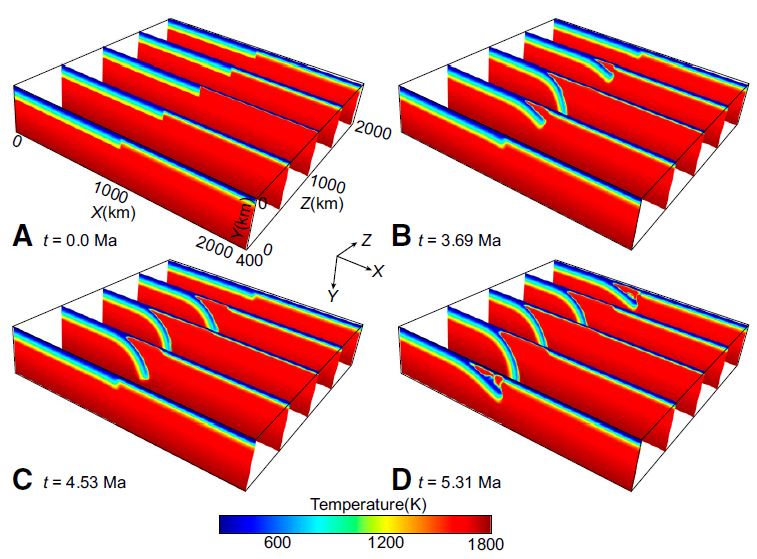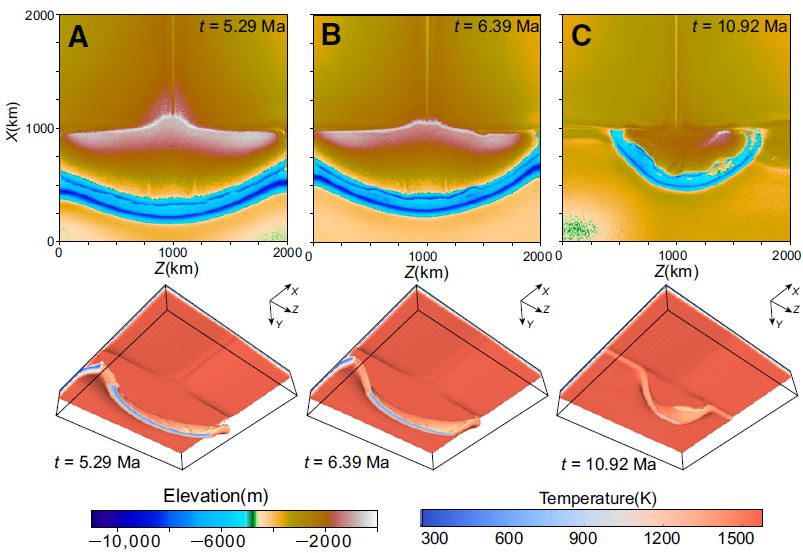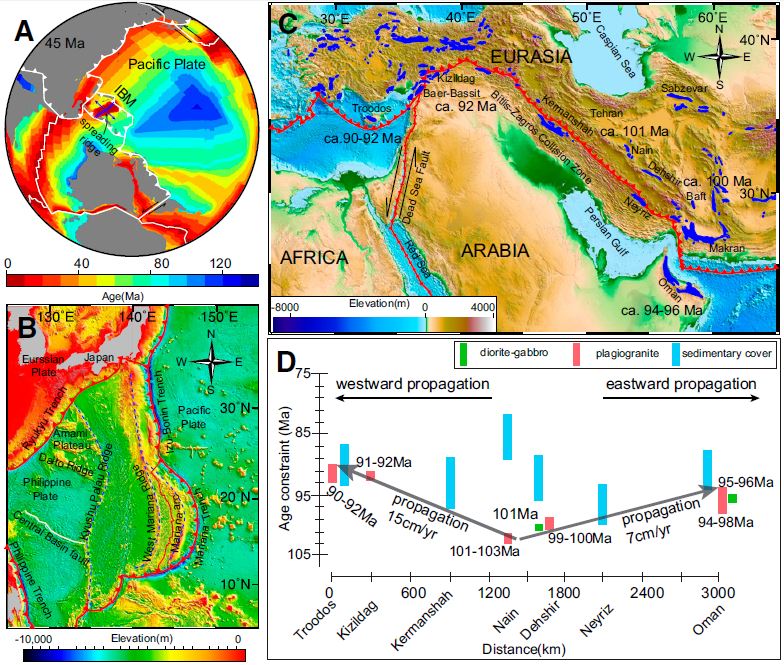【国际动态】GEOLOGY: Subduction initiation dynamics along a transform fault control trench curvature and ophiolite ages
Understanding how new subduction zones form is essential for complete articulation of plate tectonic theory. Formation of new subduction zones by collapse of oceanic transform faults or fracture zones is suggested on the basis of empirical evidence. This process has heretofore been investigated with two-dimensional (2-D) numerical models, which thus ignore its intrinsic three-dimensional (3-D) geometry, lateral propagation, and dynamics. Zhou et al. (2018) investigate a 3-D thermomechanical model, in which old and thick oceanic lithosphere (plate) is separated by a transform fault from a thinner and younger oceanic plate containing a transform-orthogonal spreading ridge. The results suggest that the older plate starts to sink spontaneously at the ridge–transform fault junction, and then subduction initiation laterally propagates along the transform away from the ridge. Two key factors control the 3-D subduction initiation (SI) dynamics in nature: (1) the age of the sinking plate, which controls its negative buoyancy; and (2) the thermal structure of the overriding plate, which reflects its spreading history. Their numerical models not only shed new light on the SI dynamics of Cenozoic subduction zones (e.g., the Izu-Bonin-Mariana zone in the Pacific Ocean), but also have implications for fossil convergent plate margins (e.g., the Bitlis-Zagros suture zone, west of the Strait of Hormuz). In the latter case, systematic variations in ages of supra–subduction zone ophiolites may reflect diachronous SI and its lateral propagation.

Figure 1. Modeled subduction initiation along transform fault separating old sinking
plate (left side) from young overriding plate with mid-ocean ridge (right side) (t—time).
Subduction initiation first occurs at transform fault–ridge junction in center, and then
laterally propagates along transform to both sides.

Figure 2. Schematic diagram showing development of subduction initiation propagation along
transform fault. First column shows bottom view of subducting and overriding plates. Second
column shows top view of topography evolution. Third column shows second invariant of
strain rate at a constant depth of 25 km, in which the velocity field is represented by black
arrows (II is the second invariant of strain rate tenso).

Figure 3. Models with different ages of subducting oceanic plate. A: 100 Ma. B: 70 Ma. C: 40
Ma. Overriding plates are same in each model, with ages of 0 Ma to 20 Ma from central midocean
ridge (MOR) to lateral edges. Top row shows top view of topography evolution. Bottom
row shows bottom view of subducting and overriding plates.

Figure 4. A: Global plate tectonic reconstruction at 45 Ma, showing that Pacific plate subducts
under mid-ocean ridge along Izu-Bonin-Mariana (IBM) subduction zones (data from Müller
et al., 2008). B: Modern IBM subduction zones. C: Tectonic setting of eastern Mediterranean-
Zagros region and compiled ages of ophiolites (blue areas) along suture zone (data from
Mann and Taira, 2004; Shafaii Moghadam et al., 2013a). D: Simplified chart showing regular
age distribution of supra–subduction zone (SSZ) ophiolites along Bitlis-Zagros suture zone
(after Shafaii Moghadam et al., 2013a), which implies that subduction initiation propagated
along strike, consistent with our numerical models. The x-axis represents the geographic
locations of the ophiolites.
文献来源:Xin, Zhou, Zhong-Hai Li, Taras V. Gerya, et al. Subduction initiation dynamics along a transform fault control trench curvature and ophiolite ages [J]. Geology, 2018, 46 (7): 607-610. (原文链接)
.png)
